Geninah
Sur cette page, vous trouverez tous les documents, offres groupées et cartes mémoire flash proposés par le vendeur geninah.
- 31
- 0
- 3
Community
- Abonnés
- Abbonements
34 éléments
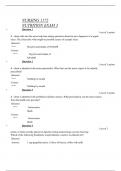
NURSING NUTRITION THERAPY
NUTRITION EXAMS/NUTRITION PRINCIPALS STUDY GUIDE/HOSA NUTRITION EXAM/NUTRITION AND DIET THERAPY/ENTERAL AND PARENTERAL NUTRITION.
- Pack
- • 5 éléments •
- nursing 1172 nutrition exam 3 (latest with answers) • Examen
- NUTRITIONAL PRINCIPALS STUDY GUIDE EXAM 1 • Examen
- HOSA NUTRITION EXAM _3_TEST • Examen
- NUTRITION AND DIET THERAPY(NUTRITION THERAPY) • Examen
- ENTERAL AND PARENTERAL NUTRITION • Examen
NUTRITION EXAMS/NUTRITION PRINCIPALS STUDY GUIDE/HOSA NUTRITION EXAM/NUTRITION AND DIET THERAPY/ENTERAL AND PARENTERAL NUTRITION.

ENTERAL AND PARENTERAL NUTRITION
ENTERAL AND PARENTERAL NUTRITION QUESTIONS AND ANSWERS
- Package deal
- Examen
- • 2 pages •
ENTERAL AND PARENTERAL NUTRITION QUESTIONS AND ANSWERS

NUTRITION AND DIET THERAPY(NUTRITION THERAPY)
DETAILED BREAKDOWN OF ALL TOPICS/QUESTIONS AND ANSWERS/GANERAL NUTRITION AND DISEASE MANAGEMENT/NUTRITIONAL SUPPORT FOR DIABETES,HEARTDISEASE,KIDNEY DISEASE, GASTROINTESTINAL DISORDERS,CANCER PATIENTS, LIVER DISEASE, OBESITY AND WEIGHT MANAGEMENT,AUTO-IMUNE DISORDERS,OSTEOPOROSIS AND BONE HEALTH/ GENERAL CONCEPTS OF ENTERAL AND PARENTERAL NUTRITION/TYPES OF ENTERAL NUTRITON/ LATEST
- Package deal
- Examen
- • 19 pages •
DETAILED BREAKDOWN OF ALL TOPICS/QUESTIONS AND ANSWERS/GANERAL NUTRITION AND DISEASE MANAGEMENT/NUTRITIONAL SUPPORT FOR DIABETES,HEARTDISEASE,KIDNEY DISEASE, GASTROINTESTINAL DISORDERS,CANCER PATIENTS, LIVER DISEASE, OBESITY AND WEIGHT MANAGEMENT,AUTO-IMUNE DISORDERS,OSTEOPOROSIS AND BONE HEALTH/ GENERAL CONCEPTS OF ENTERAL AND PARENTERAL NUTRITION/TYPES OF ENTERAL NUTRITON/ LATEST

BASIC GERIATRIC NURSING ALL TOPICS,CONCEPTS OF AGING AND CHRONIC ILLNESS 2024/2025
GERIATRIC NURSING CONCEPTS OF AGING AND CHRONIC ILLNESS ,100% CORRECT QUESTIONS AND ANSWERS FROM ALL TOPICS. BASIC CONCEPTS OF GERIATRIC NURSING LATEST 2024/2025
- Examen
- • 21 pages •
GERIATRIC NURSING CONCEPTS OF AGING AND CHRONIC ILLNESS ,100% CORRECT QUESTIONS AND ANSWERS FROM ALL TOPICS. BASIC CONCEPTS OF GERIATRIC NURSING LATEST 2024/2025
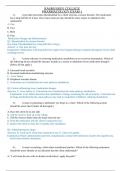
PHARMACOLOGY EXAM QUESTIONS AND ANSWERS 2024/2025
1.) A provider prescribes phenobarbital for a client who has a seizure disorder. The medication has a long half-life of 4 days. How many times per day should the nurse expect to administer this medication? A. One B. Two C.Three D. Four Medication Dosage and Administration Q1: Phenobarbital for seizure disorder Key Point: Phenobarbital has a long half-life (4 days). Answer: A. One dose per day. Explanation: Medications with long half-lives require less frequent dosing to maintain therape...
- Examen
- • 11 pages •
1.) A provider prescribes phenobarbital for a client who has a seizure disorder. The medication has a long half-life of 4 days. How many times per day should the nurse expect to administer this medication? A. One B. Two C.Three D. Four Medication Dosage and Administration Q1: Phenobarbital for seizure disorder Key Point: Phenobarbital has a long half-life (4 days). Answer: A. One dose per day. Explanation: Medications with long half-lives require less frequent dosing to maintain therape...
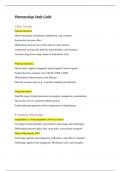
pharmacology study guide 2024/2025
I. Basic Concepts Pharmacokinetics Define absorption, distribution, metabolism, and excretion. Explain the first-pass effect. Differentiate between zero-order and first-order kinetics. Understand concepts like half-life, bioavailability, and clearance. Calculate drug doses using volume of distribution (Vd). Pharmacodynamics Define terms: agonist, antagonist, partial agonist, inverse agonist. Explain the dose-response curve (EC50, ED50, LD50). Differentiate between potency and efficac...
- Examen
- • 4 pages •
I. Basic Concepts Pharmacokinetics Define absorption, distribution, metabolism, and excretion. Explain the first-pass effect. Differentiate between zero-order and first-order kinetics. Understand concepts like half-life, bioavailability, and clearance. Calculate drug doses using volume of distribution (Vd). Pharmacodynamics Define terms: agonist, antagonist, partial agonist, inverse agonist. Explain the dose-response curve (EC50, ED50, LD50). Differentiate between potency and efficac...
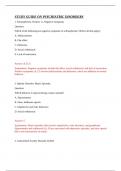
STUDY GUIDE; PSYCHIATRIC DISODERS COMPLETE SOLUTION ANSWERS A+ GRADED 2024/2025 ATI MENTAL HEALTH WITH DEEPER EXPLANATION
1. Schizophrenia: Positive vs. Negative Symptoms Question: Which of the following are negative symptoms of schizophrenia? (Select all that apply): A. Hallucinations B. Flat affect C. Delusions D. Social withdrawal E. Lack of motivation Answer: B, D, E Explanation: Negative symptoms include flat affect, social withdrawal, and lack of motivation. Positive symptoms (A, C) involve hallucinations and delusions, which are additions to normal behavior. 2. Bipolar Disorder: Manic Episodes Que...
- Examen
- • 21 pages •
1. Schizophrenia: Positive vs. Negative Symptoms Question: Which of the following are negative symptoms of schizophrenia? (Select all that apply): A. Hallucinations B. Flat affect C. Delusions D. Social withdrawal E. Lack of motivation Answer: B, D, E Explanation: Negative symptoms include flat affect, social withdrawal, and lack of motivation. Positive symptoms (A, C) involve hallucinations and delusions, which are additions to normal behavior. 2. Bipolar Disorder: Manic Episodes Que...
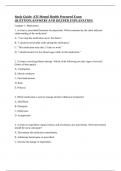
ATI MENTAL HEALTH EXAM STUDY GUIDE
Study Guide: ATI Mental Health Proctored Exam EXPANDED 1. Mental Status Exams Cognitive Ability: Asking the client to count backward by sevens. Affect: Observing facial expressions. Language Ability: Instructing the client to write a sentence. Remote Memory: Incorrectly identified by asking clients to repeat objects (not the correct method). Abstract Thinking: Asking the client to identify recent presidents.
- Examen
- • 15 pages •
Study Guide: ATI Mental Health Proctored Exam EXPANDED 1. Mental Status Exams Cognitive Ability: Asking the client to count backward by sevens. Affect: Observing facial expressions. Language Ability: Instructing the client to write a sentence. Remote Memory: Incorrectly identified by asking clients to repeat objects (not the correct method). Abstract Thinking: Asking the client to identify recent presidents.
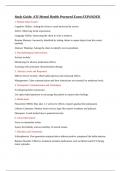
ATI MENTAL HEALTH STUDY GUIDE WITH DEEPER EXPLANATION
Study Guide: ATI Mental Health Proctored Exam EXPANDED 1. Mental Status Exams Cognitive Ability: Asking the client to count backward by sevens. Affect: Observing facial expressions. Language Ability: Instructing the client to write a sentence. Remote Memory: Incorrectly identified by asking clients to repeat objects (not the correct method). Abstract Thinking: Asking the client to identify recent presidents.
- Examen
- • 6 pages •
Study Guide: ATI Mental Health Proctored Exam EXPANDED 1. Mental Status Exams Cognitive Ability: Asking the client to count backward by sevens. Affect: Observing facial expressions. Language Ability: Instructing the client to write a sentence. Remote Memory: Incorrectly identified by asking clients to repeat objects (not the correct method). Abstract Thinking: Asking the client to identify recent presidents.
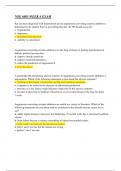
NSG 6005 WEEK 6 EXAM
Ray has been diagnosed with hypertension and an angiotensin-converting enzyme inhibitor is determined to be needed. Prior to prescribing this due, the NP should assess for: a. hypokalemia. b. impotence. c. decreased renal function. d. inability to concentrate. Angiotensin-converting enzyme inhibitors are the drug of choice in treating hypertension in diabetic patients because they: a. improve insulin sensitivity. b. improve renal hemodynamics. c. reduce the production of angiotensin II. ...
- Examen
- • 17 pages •
Ray has been diagnosed with hypertension and an angiotensin-converting enzyme inhibitor is determined to be needed. Prior to prescribing this due, the NP should assess for: a. hypokalemia. b. impotence. c. decreased renal function. d. inability to concentrate. Angiotensin-converting enzyme inhibitors are the drug of choice in treating hypertension in diabetic patients because they: a. improve insulin sensitivity. b. improve renal hemodynamics. c. reduce the production of angiotensin II. ...
